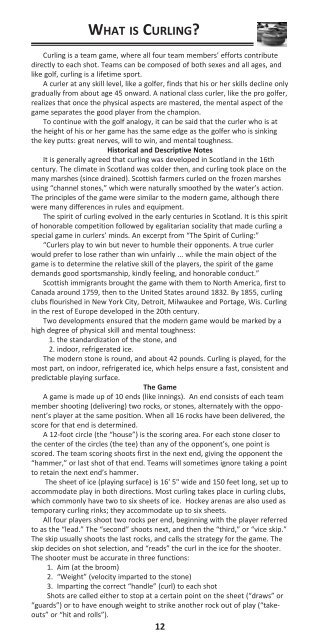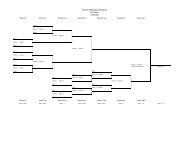USCA Media Guide - Great Lakes Curling Association
USCA Media Guide - Great Lakes Curling Association
USCA Media Guide - Great Lakes Curling Association
You also want an ePaper? Increase the reach of your titles
YUMPU automatically turns print PDFs into web optimized ePapers that Google loves.
WhAT Is CURlInG?<br />
<strong>Curling</strong> is a team game, where all four team members’ efforts contribute<br />
directly to each shot. Teams can be composed of both sexes and all ages, and<br />
like golf, curling is a lifetime sport.<br />
A curler at any skill level, like a golfer, finds that his or her skills decline only<br />
gradually from about age 45 onward. A national class curler, like the pro golfer,<br />
realizes that once the physical aspects are mastered, the mental aspect of the<br />
game separates the good player from the champion.<br />
To continue with the golf analogy, it can be said that the curler who is at<br />
the height of his or her game has the same edge as the golfer who is sinking<br />
the key putts: great nerves, will to win, and mental toughness.<br />
historical and Descriptive notes<br />
It is generally agreed that curling was developed in Scotland in the 16th<br />
century. The climate in Scotland was colder then, and curling took place on the<br />
many marshes (since drained). Scottish farmers curled on the frozen marshes<br />
using “channel stones,” which were naturally smoothed by the water’s action.<br />
The principles of the game were similar to the modern game, although there<br />
were many differences in rules and equipment.<br />
The spirit of curling evolved in the early centuries in Scotland. It is this spirit<br />
of honorable competition followed by egalitarian sociality that made curling a<br />
special game in curlers’ minds. An excerpt from “The Spirit of <strong>Curling</strong>:”<br />
“Curlers play to win but never to humble their opponents. A true curler<br />
would prefer to lose rather than win unfairly ... while the main object of the<br />
game is to determine the relative skill of the players, the spirit of the game<br />
demands good sportsmanship, kindly feeling, and honorable conduct.”<br />
Scottish immigrants brought the game with them to North America, first to<br />
Canada around 1759, then to the United States around 1832. By 1855, curling<br />
clubs flourished in New York City, Detroit, Milwaukee and Portage, Wis. <strong>Curling</strong><br />
in the rest of Europe developed in the 20th century.<br />
Two developments ensured that the modern game would be marked by a<br />
high degree of physical skill and mental toughness:<br />
1. the standardization of the stone, and<br />
2. indoor, refrigerated ice.<br />
The modern stone is round, and about 42 pounds. <strong>Curling</strong> is played, for the<br />
most part, on indoor, refrigerated ice, which helps ensure a fast, consistent and<br />
predictable playing surface.<br />
The Game<br />
A game is made up of 10 ends (like innings). An end consists of each team<br />
member shooting (delivering) two rocks, or stones, alternately with the opponent’s<br />
player at the same position. When all 16 rocks have been delivered, the<br />
score for that end is determined.<br />
A 12-foot circle (the “house”) is the scoring area. For each stone closer to<br />
the center of the circles (the tee) than any of the opponent’s, one point is<br />
scored. The team scoring shoots first in the next end, giving the opponent the<br />
“hammer,” or last shot of that end. Teams will sometimes ignore taking a point<br />
to retain the next end’s hammer.<br />
The sheet of ice (playing surface) is 16' 5" wide and 150 feet long, set up to<br />
accommodate play in both directions. Most curling takes place in curling clubs,<br />
which commonly have two to six sheets of ice. Hockey arenas are also used as<br />
temporary curling rinks; they accommodate up to six sheets.<br />
All four players shoot two rocks per end, beginning with the player referred<br />
to as the “lead.” The “second” shoots next, and then the “third,” or “vice skip.”<br />
The skip usually shoots the last rocks, and calls the strategy for the game. The<br />
skip decides on shot selection, and “reads” the curl in the ice for the shooter.<br />
The shooter must be accurate in three functions:<br />
1. Aim (at the broom)<br />
2. “Weight” (velocity imparted to the stone)<br />
3. Imparting the correct “handle” (curl) to each shot<br />
Shots are called either to stop at a certain point on the sheet (“draws” or<br />
“guards”) or to have enough weight to strike another rock out of play (“takeouts”<br />
or “hit and rolls”).<br />
12





